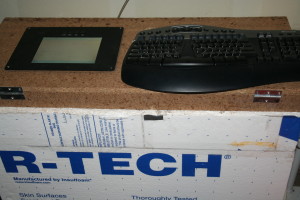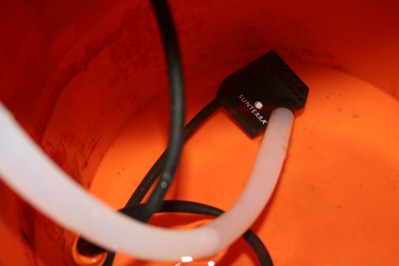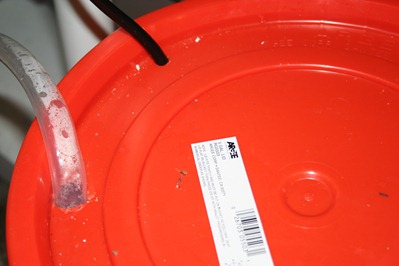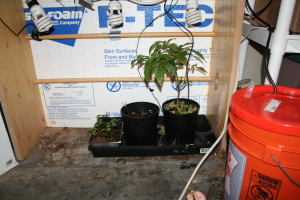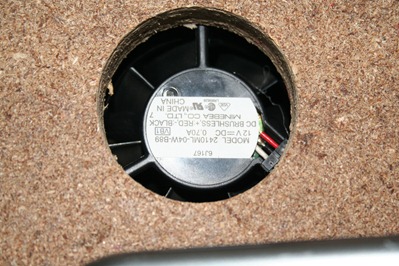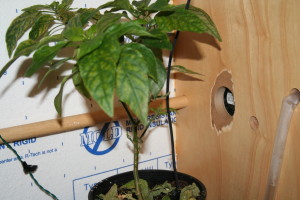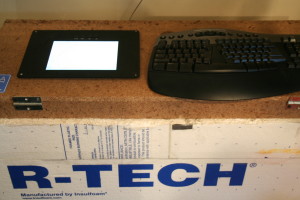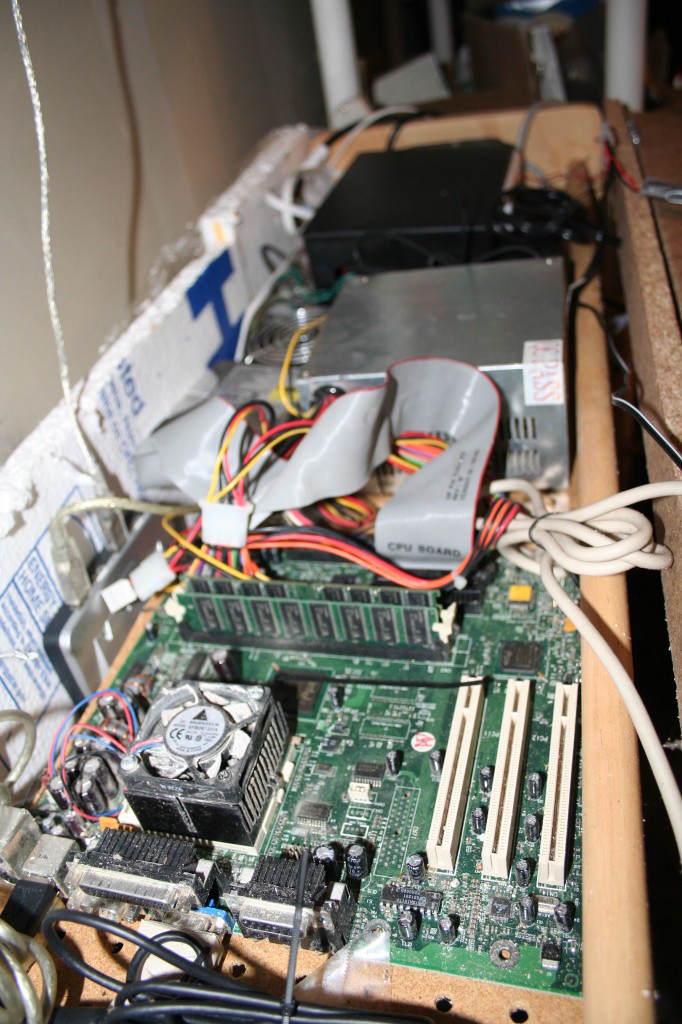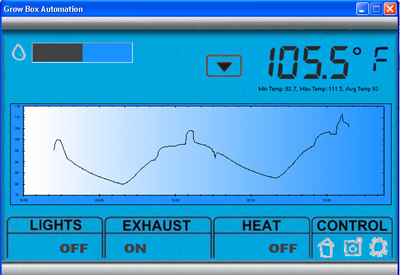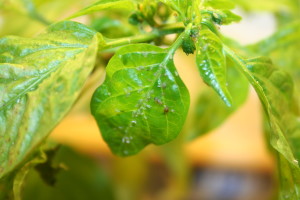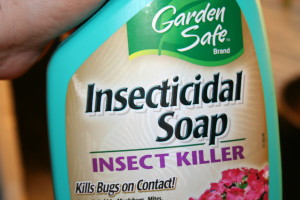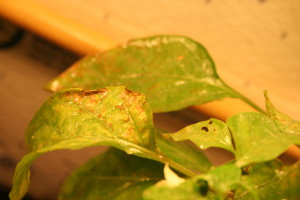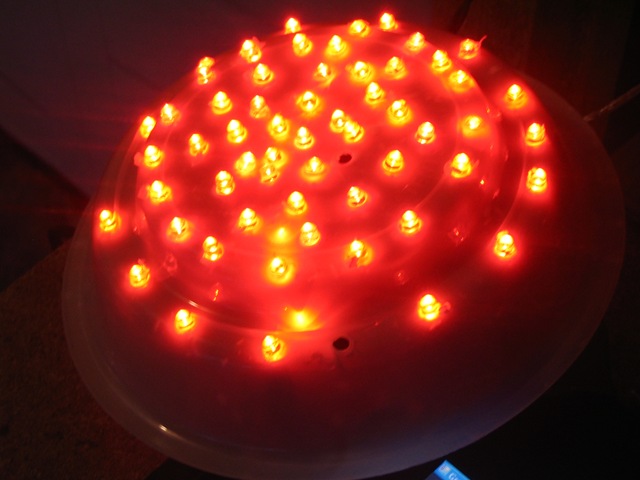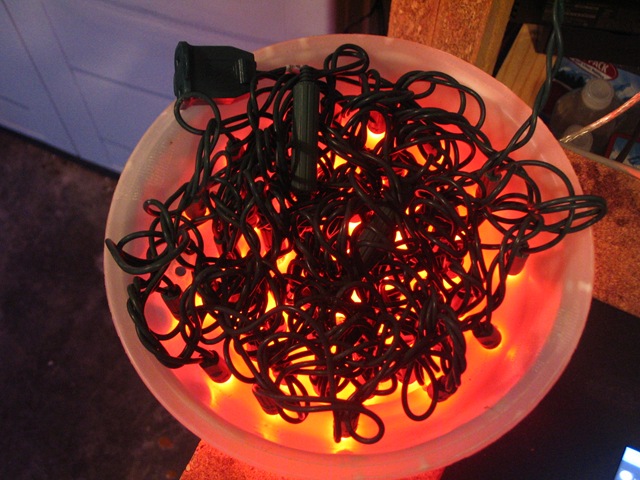Heating row tunnels and grow box with Christmas lights
14.4 years ago cheap, indoor growbox
Currently it is 16 degrees outside and given my grow box containing jalapeno peppers is in my unheated detached garage, which can bring some challenges. Like most plants, peppers will continue to grow in the range of 60 to 90 degrees, but thrive in 70 to 90 degrees. With the lights on the grow box gets to about 60 degrees but drips to the 50’s at night. This will result in plants having stunted growth and begin dropping blossoms before they can start bearing fruit.
My solution, a string of green mini Christmas lights. Just to clarify these are your typical small bulb Christmas lights not LEDs, given the efficiency of LEDs they do not product much extra heat which is what I am going for here. I also chose green Christmas lights because plants do not absorb this wavelength very well so they can be left on at night to keep heating while still letting the plants “sleep”.
Of course results will vary depending on the size of your grow box or outside row tunnel, insulation, and exterior temperature, but I am seeing 8-10 degree increase in temperature with a single string (50 bulbs)
I am always open to new ideas to safely, cheaply and efficiently heat my grow box or row tunnel so if anyone has any other suggestions please add a comment.
Tags: cheap, grow lights, growbox, led, outdoor plants, pepper plants
Computer controlled grow box – Part 2
14.6 years ago indoor growbox, water
Though I have made some significant changes to the grow box controller, the actual grow box has undergone some minor but important changes over the past few months.
Automated watering
Now I must say this one is pretty darn simple. Though I will be planning on a slightly more complicated hydroponic setup later I decided to start with a very easy bottom watering technique. Just take a regular old fountain pump (I went with the cheapest I could find) drop it in a 5 gallon bucket of water and attach a hose long enough to reach your planting tray and plug in the power to the pump to your grow box controller and that’s about it.
To prevent evaporation and algae and little bugs making a home in my nice bucket of water, I added a lid with two holes for the water output and power input. The power input required me to make a straight cut with a utility knife to ensure a snug fit while not requiring me to cur the AC line to feed the wire through.
I also cut a hole of the same size as the water output on the bucket lid to the grow box to allow the line to enter while still keeping the box closed.
Exhaust fan control
Air circulation is important for plants to be healthy but when the box gets warmer than expected I installed two controlled CPU fans to help regulate temperate as well as one static fan that constantly pushes air from the top to bottom.
I added a 12 volt exhaust fan to the top of the box (pictured above) to help push hot air out of the grow box with another (pictured below) at the lower part of the grow box to push in cold air as needed. Both of these fans are powered by a 12 volt power wall adapter plugged into the grow box controller.
Heating
Though the computer and lights allow the box to create a comfortable internal temperature, sometimes it needs a little help. For this I installed a regular old seedling heater to hopefully take a little sting out of the cold floor the seed tray is sitting one. Like other components this was simply plugged into the grow box controller.
Putting it all together
My previous version was a little sloppily put together with duct/packing tape (lets just call it prototyping). Though this added some hackiness appear it wasn’t too functional so I added a little strip of wood to support a couple hinges which I created a top which holds the LCD panel.
Upon opening the top you can see the grow box controller and the state of the art 600 MHz PC in all their glory.
As you can see I have still have some cleaning up to do with compress air and maybe a few more zip ties but all in all everything seems to have come together nicely.
Tags: cheap, garden seeds, grow lights, growbox, led, outdoor plants, vegetables
Grow box during the summertime – UPDATE
14.8 years ago computer, indoor growbox
UPDATE: With weather climbing my grow box got up to 111.5 degrees today with the lights off. If I was using one of those fancy computers with temperature sensors it would have turned itself off by now. Turning off computer so I will have something working this winter…
[July 25, 2009] I was planning on growing my jalapeno peppers in my grow box this summer, but given the higher than average weather we have been having.
With the weather being in the 90’s 100’s and given the CFLs on average increase the temperature by around 10 degrees the grow box has not been great place to grow plants unless I was thinking of growing cacti. Looking at my historical data the highest temperature this summer was 107.6 111.5 degrees.
As you can see above I have been making some progress on the computerized grow box, which I will plan on writing it up soon…
Tags: cheap, grow lights, growbox, outdoor plants, pepper plants, vegetables
Getting rid of aphids on pepper plants
14.9 years ago aphids, brown spots, ladybugs, peppers
It can be difficult getting rid of aphids on plants in your garden. Fortunately you can get rid of those aphids with materials you have in your kitchen.
First of all I am a little embarrassed that I let the infestation get this bad before noticing. I unfortunately set the grow box to have the sunrise at 1:00am and the lights always were off by the time I got home. Though the cause is not as important as how to get rid of them.
If this plant was outside my local lady bug population would have kept these buggers in check though they seemed to thrive without the vicious predators. For an outdoor plant a quick high pressure spray of water on the the leaves (as well as underside of leaves) would take care of the problem. Though this does not kill the aphids, they will starve to death before they make it anywhere to do any more damage.
This has not been my first battle with aphids, so fortunately I had some insecticidal soap on hand. I sprayed the entire plant from the top and bottom. I removed the major yellowing leaves and did another quick spray. Now if you don’t have any insecticidal soap, or just want to save $5 on buying a bottle here are a couple of proven recipes:
Simple Aphid Killer Spray
- 1 tsp dishwashing soap
- Fill 32 oz spray bottle with water
Directions:
Shake and spray liberally on tops and bottom of leaves ensuring aphids are covered completely.
Complex Aphid Killer Spray
- 1.5 tablespoon baking soda
- 1 tablespoon Murphy’s Oil Soap
- 1 tablespoon Vegetable Oil
- 1 tablespoon Vinegar
- 1 gallon water
Directions:
Pour into spray bottle and spray liberally on tops and bottom of leaves ensuring aphids are covered completely.
Extra Spicy Aphid Killer Spray
- 3 hot peppers chopped finely
- 1 quart of water
Directions:
Mix peppers with water and let seep overnight. Strain and pour into spray bottle and spray liberally on tops and bottom of leaves ensuring aphids are covered completely. WARNING: You care not to get this spray in your eyes.
US Department of Agriculture Mix
- 2 tsp dishwashing soap
- 1 cup of vegetable oil
- Fill 32 oz spray bottle with water
Directions:
Shake and spray liberally on tops and bottom of leaves every 9-10 days, ensuring aphids are covered completely.
If none of these solutions work, squish those buggers with your fingers being sure to include a sinister laugh while doing it. Which even if you are squeamish, this is what you will see if you let them have their way.
Tags: grow lights, growbox, outdoor plants, pepper plants, vegetables
Make your own supplemental LED grow light
15.2 years ago cheap, indoor growbox, LEDs
I never got a round to making a hydroponic system out of my Cafe Steamer, but I did use part of it to create a supplemental red LED light. The construction of this was very easy and you can do the same thing with an old string of LED Christmas lights and some soft plastic (margarine or frozen dinner container) from your recycling bin.
Take the plastic and drill evenly spaced holes through the plastic. Make sure to do a few test holes with a few different bits to determine which will allow a snug fit but not causing you to force/break the bulbs. Once all the holes are drilled, carefully slide in all the bulbs, plug it in, and your project is done.
I am adding this one to my computerized grow box as a little supplemental light for my peppers plants, which I am planning on growing completely indoors this year.
Tags: cheap, garden seeds, grow lights, growbox, led, outdoor plants, pepper plants, vegetables
Light sensitive automated grow light
15.2 years ago electronics, indoor growbox, indoor seed starting
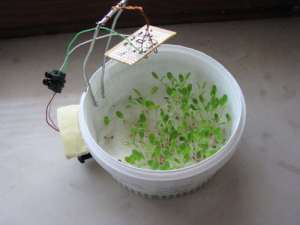
I came across this interesting concept for an automated grow light. It uses a photoresister to detect when lights get low and proceeds to turns on some red LEDs to provide the plants a few extra hours of light.
From my experience if you are growing indoors, your seedlings can use as much supplemental lighting as they can get and would recommend turning them on when there is light as well, but though still a very cool project.
This could be an interesting concept for something like a greenhouse during the fall/winter seasons though.
Via Hack-A-Day via Instrucatable
Tags: cheap, garden seeds, grow lights, led, outdoor plants, vegetables

